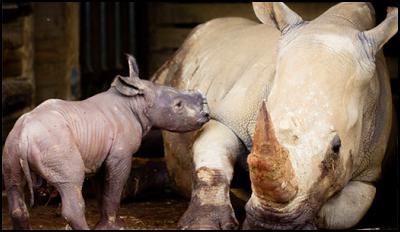Hamilton Zoo Announces Arrival of Baby Rhino
Hamilton Zoo Announces Arrival of Baby Rhino
6 July 2016

A male southern white rhinoceros calf has been born at Hamilton Zoo.
Arriving in late June after his mother's 16-month pregnancy, the calf brings the total number of white rhinos at Hamilton Zoo to six. The male calf joins his mother Kito, father Kruger, and females Imani, Moesha and her daughter Jamila.
The calf is the third for Kito. Ubuntu, born in 2010 was initially born blind, needing help from keepers in his first few weeks until his eyesight cleared, and another female was sadly stillborn in 2013.
Team Leader of Ungulates (hooved animals) Aaron Gilmore says the calf is healthy, and very keen to feed from Kito.
“He’s a determined little guy, weighing around 63 kilos at birth and already showing his strength,” says Mr Gilmore.
“Depending on weather and his continued growth, school holiday visitors will hopefully have the chance to see him in the exhibit with his mother for short periods of time each day.”
Hamilton’s white rhino breeding programme has been exceptionally successful with seven rhinos born at the zoo. They include male Kifaru, who went to The National Zoo and Aquarium in Canberra along with Ubuntu. Males Inkosi and Mtoto are at Auckland Zoo, while females Imani and Jamila remain at Hamilton Zoo.
Named for the Afrikaans word “weit” which means wide, referring to the animal’s wide mouth, the southern white rhino was thought to be extinct in the late 19th century, but in 1895 a small population of less than 100 individuals was discovered in Kwazulu-Natal, South Africa.
Today, after 121 years of successful protection and management, they are classified as “Near Threatened” in the wild.
Although still hunted and poached for their horns - believed to have medicinal qualities in some cultures - about 20,000 animals exist in protected areas and private game reserves. Zoos play their part by showcasing animals as ambassadors for wild populations and conservation projects, as well as providing genetically sound reserve populations.
“This calf is a very important part of the Australasian breeding programme, and will aid long-term conservation efforts at Hamilton Zoo and help provide a future for the species as a whole,” says Mr Gilmore.
For video of the baby rhino, click here.
ends


 Gordon Campbell: On The Hikoi Aftermath
Gordon Campbell: On The Hikoi Aftermath Stats NZ: National Population Estimates: At 30 September 2024 (2018-base)
Stats NZ: National Population Estimates: At 30 September 2024 (2018-base) NZ Government: New Zealand’s COP29 National Statement
NZ Government: New Zealand’s COP29 National Statement Surf Life Saving NZ: Volunteer Lifeguards Make Big Effort To Keep Us Safe, As Paid Lifeguard Service Commences In Northern Region
Surf Life Saving NZ: Volunteer Lifeguards Make Big Effort To Keep Us Safe, As Paid Lifeguard Service Commences In Northern Region Action Station: Biggest Ever Community Petition, With Over 200,000 Signatures, Opposes Treaty Principles Bill
Action Station: Biggest Ever Community Petition, With Over 200,000 Signatures, Opposes Treaty Principles Bill Palestinians for Hīkoi mō te Tiriti: Statement From Palestinian Leaders - Hīkoi Mō Te Tiriti Is A Historic Moment For All In Aotearoa
Palestinians for Hīkoi mō te Tiriti: Statement From Palestinian Leaders - Hīkoi Mō Te Tiriti Is A Historic Moment For All In Aotearoa Anglican Church in Aotearoa: Anglican Archbishops To Join Hīkoi Mō Te Tiriti In Wellington
Anglican Church in Aotearoa: Anglican Archbishops To Join Hīkoi Mō Te Tiriti In Wellington


